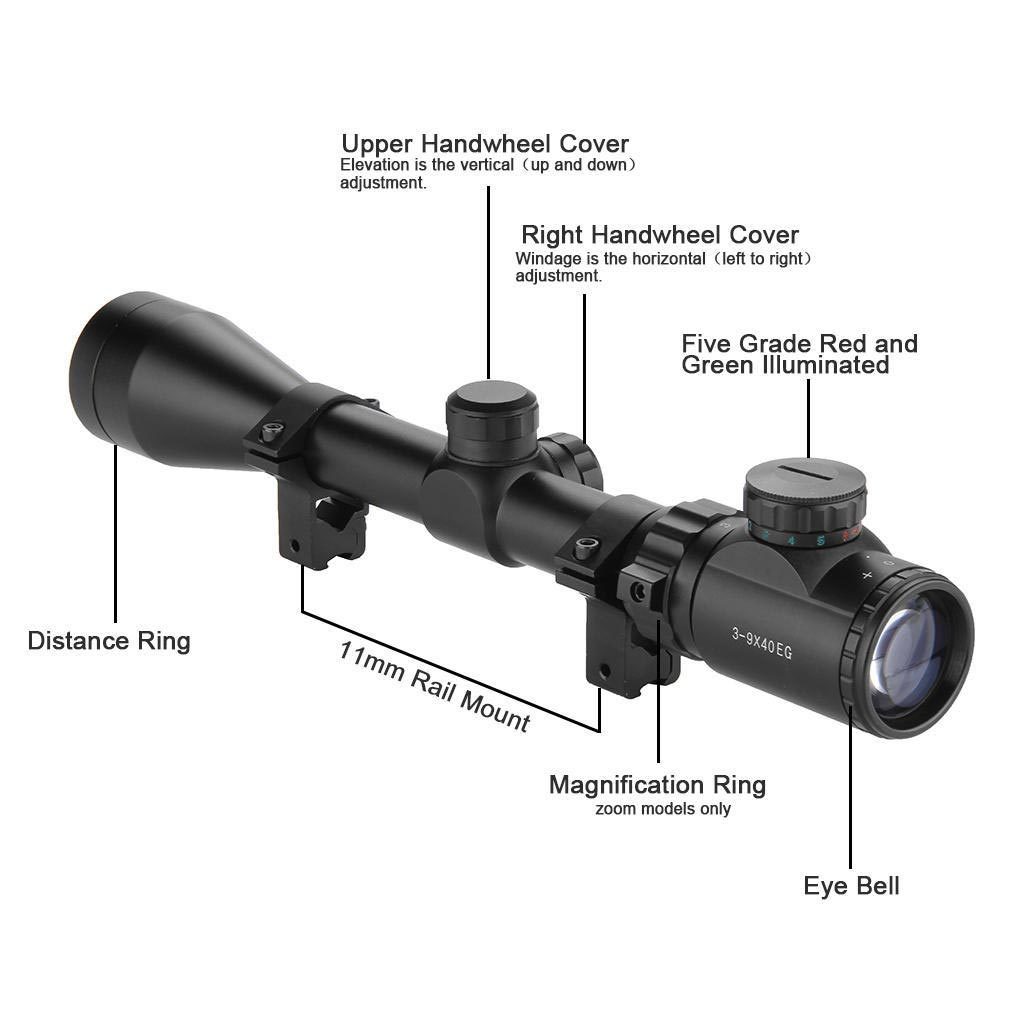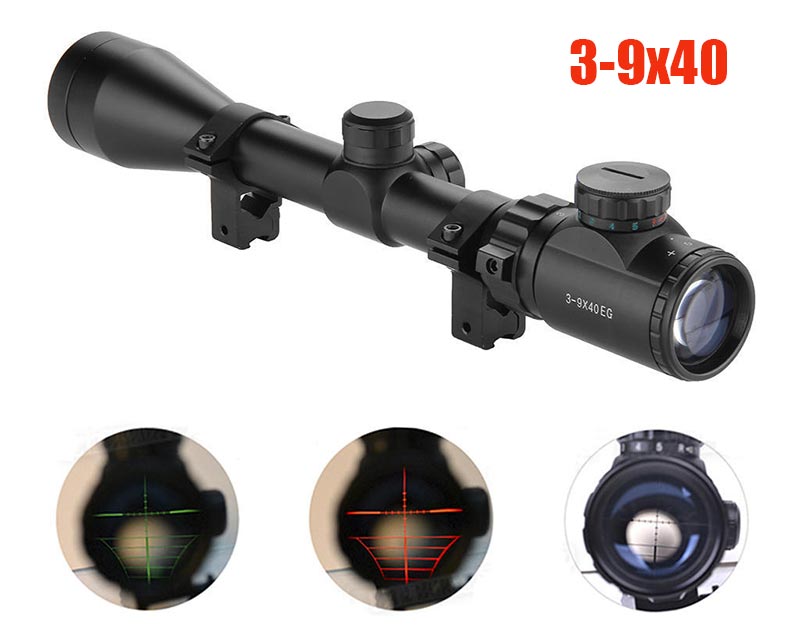Most gun enthusiasts have more than one firearm, and when it comes to ‘ranged weapons,’ such as a sniper rifle or pellet gun, you need more than the naked eye to hit targets at a long distance. This makes every shooter want to go in search of the best rifle scope. If you are new to riflescope, you might have seen a range of numbers that indicate different features of the scope. Your question like every other newbie would likely be; “what do the numbers mean on a rifle scope?”

The Numbers That Influence What You Can see
A rifle scope is a small telescope that can be used to help you hit your targets more accurately. With that in mind, let’s begin with magnification power and work our way up.
There are two major types of scope: Fixed power scopes and variable power scopes. A fixed power scope has only one magnification while a variable power scope has a wide range of magnification (i.e variable magnification).
There are three factors that characterize rifle scope numbers, and they are lower magnification, higher magnification, and objective lens diameter.
Variable power scope

A 3-9×40 scope is an example of a common rifle scope. This indicates that the scope will have a minimum magnification of three, an adjustable 9 times magnification, and an objective lens diameter of 40mm. The bigger the objective lens, the more light that would enter the scope.
A scope’s specs will include numbers for MOA, eye relief, parallax, weight, length, and field of vision.
Fixed power scope
A fixed power scope with no magnification range will be labeled 4×40 or something like that. A single number before the x indicates that you cannot make an adjustment to the magnification power.
Using iron sights on a long range weapon cannot be productive, this is because the naked eye can only provide so much precision. A good scope should provide a clearer and closer view. Even the most basic rifle scopes have magnification, allowing a shooter to zoom in on a faraway target and achieve incredible precision. Would it be wrong if you always hit your target? Certainly not!
The scope is an integral part of a rifle, yet many people overlook its importance in each shot.
Scope Specifications And Description
Suppose you come across a scope labeled 3-9×40, how would you decipher it?
Let’s go through what each number implies in more detail.
3 – This could be referred to as 3X, which stands for three power. That is, the target item will appear three times closer with this specific scope than it would with the naked eye.
9 – This value denotes 9X. This is the scope’s greatest zoom, thus the target item will look nine times closer than it does with the naked eye.
The 3 and 9 are separated by a dash (3-9), indicating the magnification range of the scope. A scope described in this manner will include a power ring around the ocular lens that allows you to zoom in and out. The magnification increases as you turn the power ring.
x40 – This figure indicates that the objective lens has a diameter of 40mm. This diameter determines the amount of light (light transmission) that would be allowed into the scope, therefore the bigger it is, the better it may be for night shooting.
In the end, this scope would be referred to as a ‘three to nine by forty scope’.
The objective lens required by a shooter is primarily determined by how the weapon is used. A 5-25×50 scope will be too large for a pellet gun but adequate for a long-range sniper rifle. As a result, it’s typically a good idea to match the objective lens to the distance you’re shooting from.
Other Numbers In A Rifle Scope
When you take a careful look at the specifications on a rifle scope, the objective lens diameter and the magnification are usually included in the manufacturer’s naming of their product.
As an example, consider the Vortex Optics Diamondback 6-24×50 and Hawke Vantage 3-9×40.
The standard format: the company name, the model, the minimum magnification, the highest magnification, and lastly the objective lens diameter.
These, however, are not the only figures related to the scope.
Let’s go through the others!
MOA
Measured in angles or degrees, or as a fraction of an MOA (for example, ¼ MOA).
MOA is an abbreviation for ‘Minutes Of Angle.’ It’s a circle measuring unit that is 1.0472 inches at 100 yards, which is so near to 1 inch that it’s represented that way. A scope reticle, for example, could be 2MOA. So at 100 yards, it’s 1 inch and 2 inches at 200 yards and so on. It quantifies the difference in angle as the length of the shot is increased.
Field of view
This scope number is labeled in feet or degrees at a specified distance. This is the view area visible while gazing through the rifle scope. It is closely related to magnification since the viewable area decreases as you zoom in. Moving targets need a larger field of view.
8.7-2.9m @100m implies that at maximum magnification, a 2.9m broad target would fill the scope sight image. To get the same result, the minimum zoom would have to be 8.7m.
A spotting scope will have a larger field of view than a sniper scope.
Eye relief
Eye relief is expressed as a measure of distance; ‘eye relief: 89mm.’
Eye relief is the range you need to keep your eyes away from the scope so that the whole field of view is visible. When using particularly powerful round cartridges, your eye should not be too close to the eyepiece.
Exit Pupil
Measured as a length in millimeters (eg. Exit pupil: 13-4mm)
Light that enters the scope’s objective lens travels through the scope tube and comes out from the ocular lens, where it forms a sight image. A circle of light departing the scope and entering the eye is referred to as the exit pupil. An extremely narrow exit pupil is insufficient to provide a clear and bright picture. In a low light condition, the bigger the exit pupil, the better.
The human iris measures around 2-3 mm in daylight, 4-5 mm in darker settings such as dusk, and 6 mm when darkness descends.
Tube diameter
Typically expressed as a length and measured in inch (for example: Tube: 1 inch)
The central tube of most scopes is usually 1 inch in diameter. It is sometimes given in millimeters, such as 30mm or 34mm. A bigger tube diameter allows for better elevation adjustment, and this is helpful for long range shooting. Because scopes are attached to a mount, this number implies that you will need to purchase scope rings that are the correct size for the scope tube.
Weight
Weight is expressed in ounces, grams, or kilograms (Weight: 600g)
This is nothing more than the weight of the scope, excluding the scope rings, mounts, or packaging.
Length
Measured in millimeters or inches (for example, Length: 349mm)
This is the length of the scope, not internal distances.
What Does a 4-16×50 Rifle Scope Mean?
Scopes are designed to improve the accuracy of shooters. Let’s find out what 4-16×50 means.
4 – is the smallest magnification available as a sight image. When you fully zoom out, the target becomes four times closer to the eye.
16 – The maximum zoom allowed by your scope. The visual picture will be 16 times closer than sighting with the naked eye when fully zoomed in.
The scope has a magnification ring, also known as a power ring, that will allow you to zoom out and zoom in between 4- 16 magnifications.
50 – This figure is the objective lens diameter, indicating that it is a big scope. This scope will allow more light to enter into it than a 32mm lens, making it the best rifle scope for shooting in a low light condition.
It’s widely accepted that 10x magnification is the least for 1000 yards, therefore this scope should be able to see targets at that range.
What Does a 4-12×50 Rifle Scope Mean?
So let’s take another example (4-12×50).
4 – This number is the smallest magnification available. When you fully zoom out, the target becomes four times closer.
12 – The maximum zoom allowed by your scope. The visual picture will be 12 times closer to the eye when fully zoomed in.
This sight contains a magnification ring, also known as a power ring, that will allow you to zoom in and zoom out between 4 – 12 magnifications.
50 – This lens diameter indicates it is a big scope. The scope will allow more light transmission than the 32mm lens, making it the best scope for low light conditions.
These rifle scope numbers ( 4-16×50 and 4-12×50) are similar because they have a magnification range, let’s find out what could be different.
What Does a 4×32 Rifle Scope Mean?
This new specification might be a little confusing since it does not have a power range.
What do you think about this new scope number? It just indicates that the scope magnification power is fixed. Most scopes allow you to zoom in and zoom out, this is done through the adjustment of the scope power rings. A scope with the scope number 4×32 is not adjustable and would not be able to zoom in or zoom out.
This type of scope is not actually a small scope, it only means that it is useful for shooting at a specific range and your shot’s range doesn’t move much.
500-yard Scope Magnification
Before buying a scope, you must first determine what your shooting range would be. This would help you know which rifle scope magnification to go for.
So, what is the best scope that you should use if you’re target shooting at a distance of 500 yards? The 10x rule is merely a guideline for 1000 yards distance, but a solid 4-16×50 scope has the perfect magnification power for this range.
1000 Yard Scope Magnification
The lowest magnification at this range is regarded 10x. The best scope for target shooting at this range is the 6-24×50 scope because it gives the magnification power to zoom in and aim accurately.

Mike Hardesty is a published freelance gun writer. He also possesses specialized expertise in rifle scopes With dozens of articles and reviews published in Pew Pew Tactical, Snipercountry.com, and TTAG (The Truth About Guns), Mike is considered a firearms expert. His special area of expertise is handguns.
Mike is a long-time shooter. He has been punching paper targets, taking deer and other game and shooting at competitions since about 1975. Other related pursuits include reloading and bullet casting. He currently reloads for over 10 calibers, both handgun and rifle. His reloads, particularly for 9mm, were in great demand during the height of the ammo shortage among family and friends. He donated hundreds of rounds to informal shooting sessions. He was quoted as saying “I do not sell my reloads but I sure will help my guys shoot ’em for free!”. He has a few cherished firearms that he has inherited or otherwise procured — those are his favorites.
He earned B.S. and M.S. degrees from Indiana State University in 1974-1975.
He’s a firearm experts and is the founder of mhardesty.com.
